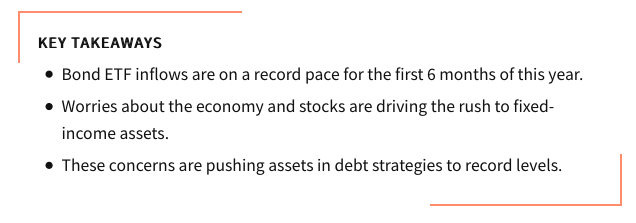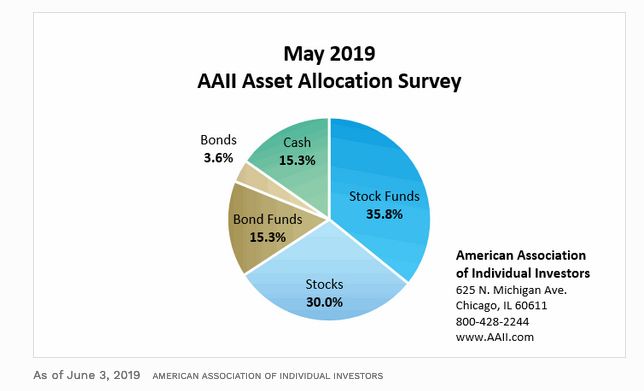The more question marks in the current state of the capital markets, the better for fixed income as record inflows could be ahead for bond exchange-traded funds (ETFs) as uncertainty surrounds the outlook for the global economy.
According to a Bloomberg story, the year-to-date inflows through early this week showed that fixed-income ETFs pulled in about $72 billion of net new capital from investors, and assets in debt strategies now equal a record $741 billion.
“Fixed income is the benefactor of an overall hangover from last year and nervousness about money going forward,” observes Eric Balchunas, an analyst with Bloomberg Intelligence. In this market, he adds, “Bond ETFs are punching way above their weight. ”

As the U.S.-China trade deal that was supposed to happen went south, investors increased their exposure to fixed income to a point where it reached a six-year high during the month of May as negotiations unraveled, according to the latest AAII Asset Allocation Survey.
As such, other notable trends included a decreased exposure to equities and an increase of investors sitting on the sidelines with cash.
Other highlights:
- Allocations to stocks and associated funds declined 2.0 percentage points to 65.8 percent
- Equity allocations remain above their historical average of 61.0 percent for the 74th consecutive month
- Bond and bond fund allocations rose 1.8 percentage points to 18.9 percent
- Fixed-income allocations were last higher in April 2013 (19.7 percent)
- May was the fourth time in five months with bond and bond fund allocations above their historical average of 16.0 percent

This latest data could provide insight on a repeat performance of fixed income’s first quarter. It’s no doubt that the volatility-laden fourth quarter of 2018 spurred an investor move to bonds, but that trend persisted in the first quarter of 2019 with $34.5 billion going into fixed income exchange-traded funds (ETFs), according to a US-Listed Flash Flows Report from State Street Global Advisors.
As opposed to simply adding a broad-based fund like the iShares Core US Aggregate Bond ETF (NYSEArca: AGG), it will take more of a strategic bent, such as looking into actively-managed funds or other corners of the bond market like municipal debt. This is especially so since the Federal Reserve said during its fourth and final rate hike in December 2018 that it will do more reassessing–the central bank already lowered its forecast to no rate hikes in 2019 as opposed to the initial two forecasted.
For more market trends, visit ETF Trends and to access up-to-date data on ETFs, visit ETFdb.com.

